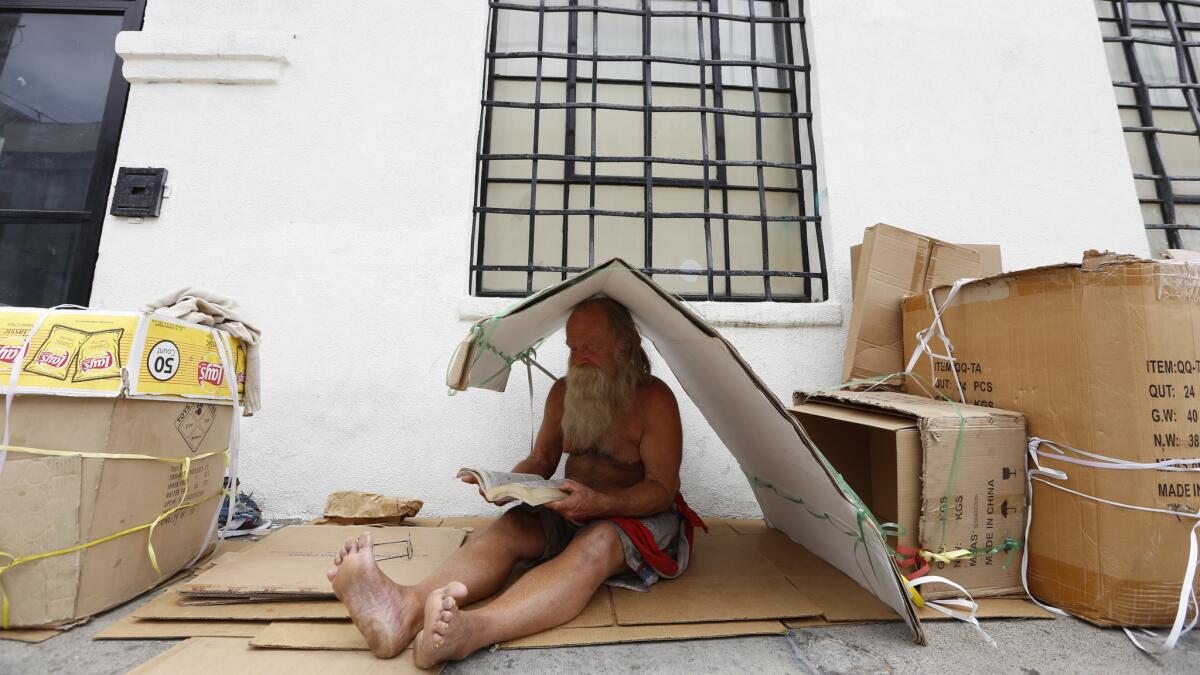Editorial: Why is it OK for the homeless to sleep on the sidewalk but not in their cars?

- Share via
There are thousands of homeless people living in cars and vans on the streets of Los Angeles; in all, some 4,600 vehicles are being used for shelter, according to the latest official homelessness count. For a variety of reasons – some reasonable, some less so – these people are not generally welcomed when they park in residential neighborhoods, and for years the city has had a law forbidding people from living in their vehicles. That law was invalidated in 2014 by a federal appeals court panel that ruled it vague and unconstitutional, leaving the city with little power to control the proliferation of vehicles.
Now, the city council is about to vote on a new ordinance describing more specifically what it means to “live” in one’s car and setting rules for when it is and is not permissible.
This is another of the many difficult decisions that has to be made to balance the needs of the city against the rights of homeless people. The new law is no panacea: It will allow a practice that no one is happy about to continue. And it certainly won’t do much to address the underlying problem of homelessness.
See more of our stories from Opinion »
But this much is clear: It would be absurd for the city to forbid homeless people to live in their cars overnight — given that it already allows people to sleep on the sidewalks overnight (as it agreed to do in a court settlement). Councilman Mike Bonin has proposed an ordinance that strikes a reasonable balance: It would prohibit people from living in vehicles on residential streets or blocks where a school is located, but would allow them to do so on commercial or industrial streets. But that would only be allowed until council districts established outposts of a citywide “safe parking program” where homeless people could park provided they engaged with caseworkers and service providers first.
Those safe parking programs could be located at parking lots offered by the city government, private businesses, nonprofits, churches or temples. Modeled on a program in Santa Barbara, the safe parking program is not intended to turn vacant lots into vehicular shanty towns but to offer a limited number of spots per lot for people to stay overnight and get connected to service providers. Once a council district had set aside enough safe parking spaces in lots, all streets in that district would be off-limits to people living in cars. The city and the Los Angeles Homeless Services Authority will have to determine what is the right number of parking spots. Bonin’s proposal also has a built-in deadline: The ordinance sunsets at the end of this year unless every council district has set up safe parking.
The city and the county need to do much more to truly address homelessness. They have both set out ambitious plans to create more permanent supportive housing, provide more outreach, and offer more rapid rehousing to people before they become chronically homeless. Now they need to follow through on those plans and find the hundreds of millions of dollars necessary to carry out them out.
But in the short term, there is no point forbidding people to live in their cars. If all works according to plan, this ordinance can help move homeless people and their vehicles off residential streets to places where they can be helped.
Follow the Opinion section on Twitter @latimesopinion and Facebook.
MORE FROM OPINION
The isolationist catastrophe of ‘Brexit’
Unlike most people accused of dishonesty, Clinton and Trump are true liars
A cure for the common opinion
Get thought-provoking perspectives with our weekly newsletter.
You may occasionally receive promotional content from the Los Angeles Times.






